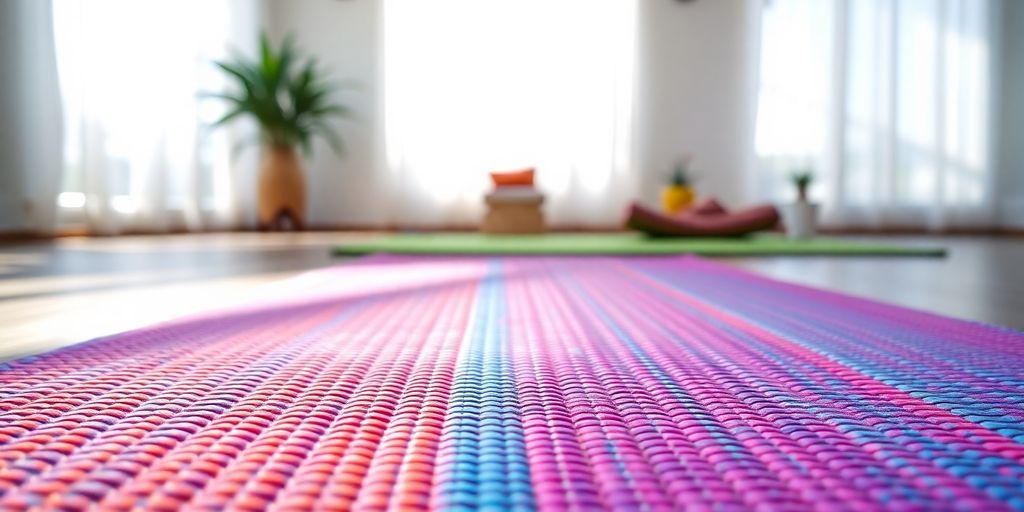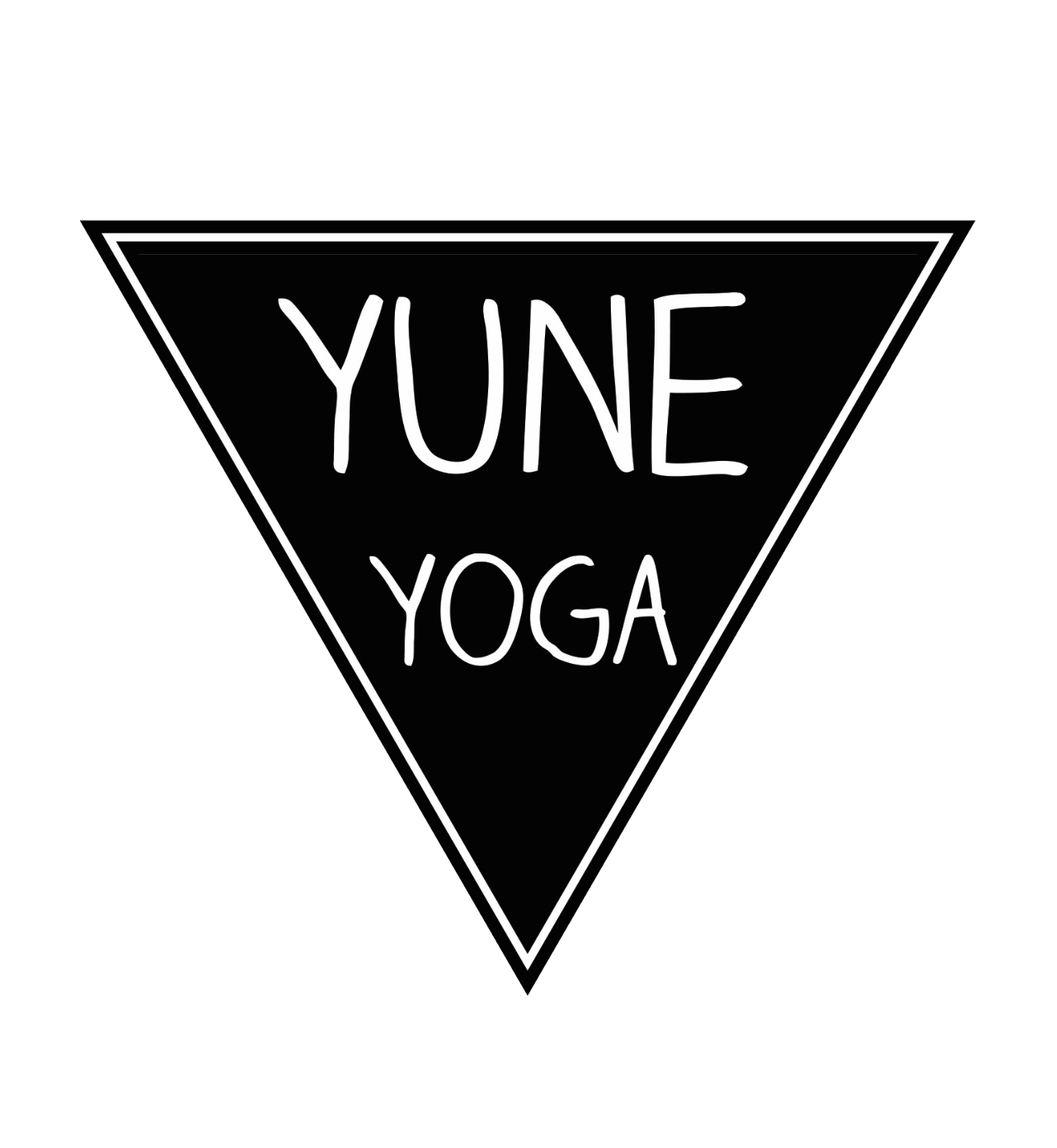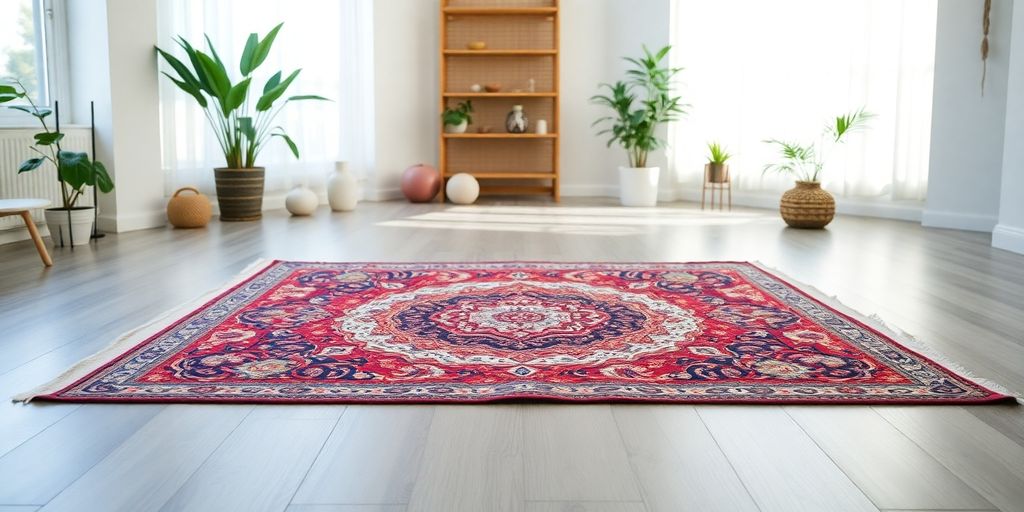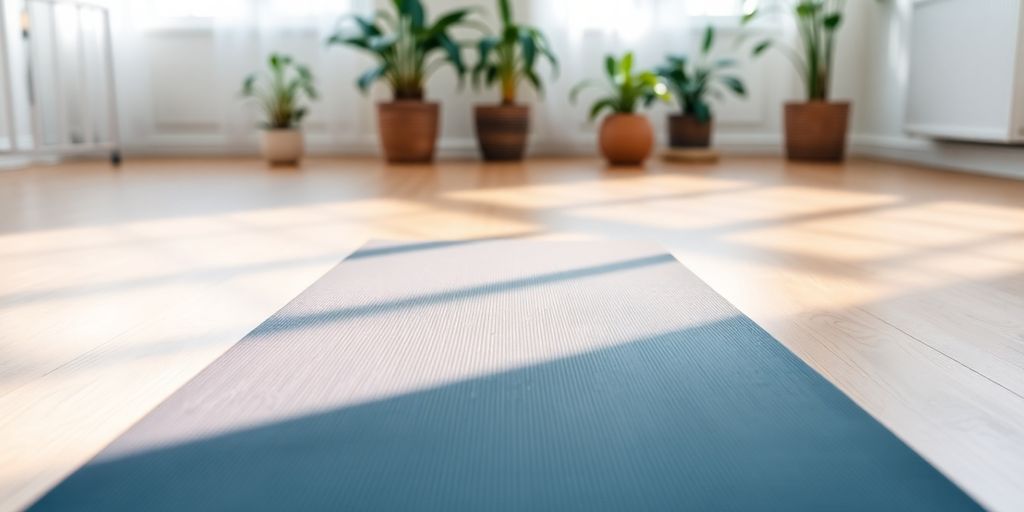
Discover the Benefits of a Grippy Yoga Mat for Your Practice in 2024
If you're diving into yoga in 2024 or just looking to upgrade your gear, a grippy yoga mat might be your new best friend. These mats aren't just about looks; they can seriously up your yoga game. From keeping you steady in those tricky poses to making sure you don't slip during a sweaty session, the right mat is a game-changer. Plus, with so many eco-friendly options out there, you can feel good about your choice. Let's break down why a grippy yoga mat is worth considering for your practice.
Key Takeaways
- A grippy yoga mat helps you maintain balance and stability during challenging poses.
- Eco-friendly mats are available, offering both sustainability and performance.
- Proper cushioning in a mat can protect your joints and reduce strain.
- Choosing the right mat thickness and texture can enhance your yoga experience.
- Grippy mats are especially beneficial in hot yoga, where sweat can make things slippery.
Enhancing Your Practice With a Grippy Yoga Mat

Establishing Personal Space
Rolling out your mat is more than just a start to your yoga session; it’s a way to carve out your personal space in a crowded studio or your living room. A grippy yoga mat serves as a boundary, grounding you in your practice and helping you focus. This personal zone allows you to disconnect from external distractions and truly immerse yourself in the moment, enhancing your overall experience.
Fostering Mindfulness
Mindfulness in yoga is about being present, and a reliable mat can aid this journey. When you’re not worried about slipping, you can concentrate on your breath and movements. The tactile feedback from a grippy surface keeps your attention on each pose, helping you to stay present and mindful throughout your practice.
Encouraging Self-Discovery
Yoga is often seen as a path to self-discovery. With a stable mat, you’re more likely to push your boundaries and try new poses. The confidence that comes from knowing your mat won’t slip encourages exploration, allowing you to learn more about your capabilities and limits. This journey of self-discovery is a key part of yoga, making each session more rewarding and insightful.
A grippy yoga mat doesn't just support your body; it supports your journey inward, helping you explore new depths in your practice.
Achieving Balance and Stability

Finding your balance and holding steady poses in yoga is a journey, not a destination. A non-rubber yoga mat can be a game-changer in this pursuit, offering eco-friendly comfort and stability.
Improving Alignment
Alignment is crucial in yoga to ensure that each pose is executed safely and effectively. A sturdy yoga mat provides a stable foundation, helping you to maintain proper alignment. This stability allows you to focus on the precise positioning of your body, reducing the likelihood of injury and enhancing the overall quality of your practice.
Reducing Slip Risks
Nobody wants to slip during a challenging pose. That's where a grippy mat comes in. A high-quality mat minimizes slip risks, especially during standing poses or when you're sweating it out in a heated class. This grip gives you the confidence to push your limits without worrying about losing your footing.
Supporting Standing Poses
Standing poses are foundational in yoga, and they require a good deal of balance. A supportive mat is essential here. It helps distribute your weight evenly across the mat, ensuring that your feet stay firmly planted. This support allows you to concentrate on your form and breathing, rather than on keeping your balance.
Promoting Body Comfort and Safety
Cushioning for Joints
When you're holding a pose, the last thing you want is to feel pain in your knees or elbows. That's where a good yoga mat comes in. A mat with the right thickness and material can provide the cushioning your joints need. A well-cushioned mat can make all the difference in your practice, especially during poses that put pressure on your knees and wrists.
- Consider mats made from materials like thermoplastic elastomer (TPE) or natural rubber for optimal support.
- Thicker mats, around 5mm, are ideal for those with sensitive joints.
- Look for mats that offer a balance between cushioning and stability.
Reducing Strain
Yoga is about finding balance, not about straining yourself. A quality yoga mat helps reduce unnecessary strain on your body, allowing you to focus on your practice. The Aomame Yoga Mat, for instance, is designed to minimize strain with its non-slip surface and supportive design.
- Choose a mat that provides a stable base to prevent muscle fatigue.
- Make sure the mat is long enough for your height to avoid overreaching.
- Anti-tear materials can prevent injuries from unexpected slips or tears.
Supporting Proper Alignment
Proper alignment is crucial in yoga to prevent injuries and get the most out of each pose. A grippy mat helps keep you stable, ensuring your body stays in the right position.
- A non-slip surface is vital for maintaining poses without slipping.
- Mats with alignment guides can be helpful for beginners.
- Consistent practice on a stable mat can improve your posture over time.
Investing in a quality yoga mat is not just about comfort—it's about safety. It supports your body in all the right places, letting you focus on your breath and movement. A good mat can transform your practice, making each session more enjoyable and less about enduring discomfort.
Eco-Friendly Choices for Conscious Yogis
Sustainable Materials
Choosing a yoga mat made from sustainable materials is a smart move for both you and the planet. Many eco-friendly mats are crafted from natural rubber, cork, or thermoplastic elastomer (TPE), which are all renewable and biodegradable. These materials not only provide a sturdy base for your practice but also help reduce your carbon footprint. Opting for sustainable materials means you're supporting practices that are kinder to our world.
Hygiene Benefits
Eco-friendly mats often come with the added benefit of being naturally resistant to bacteria and odors. Cork mats, for instance, are naturally antimicrobial, making them a great choice if you want to keep your mat fresh and clean without harsh chemicals. TPE mats also resist moisture, preventing bacteria from seeping in. This means less time worrying about germs and more time focusing on your poses.
Reducing Environmental Impact
By selecting a mat made from eco-friendly materials, you're actively participating in reducing environmental harm. These mats are typically free from harmful chemicals like phthalates and PVC, which can be detrimental to both your health and the environment. Making this choice supports a cleaner planet and promotes a healthier lifestyle. Remember, every small decision contributes to a larger impact, and choosing an eco-friendly mat is a step towards sustainability.
Investing in an eco-friendly yoga mat is more than just a personal choice; it's a commitment to the environment. With options like the Oberon Yoga Mat, you can enjoy a non-slip, durable mat that aligns with your values. Embrace the peace of mind that comes with knowing your practice is as gentle on the earth as it is on your body.
Durability and Cost-Effectiveness
Long-Lasting Performance
Finding a yoga mat that can stand the test of time is crucial. High-quality mats made from materials like natural rubber or cork are known for their durability. These materials can handle frequent use without showing signs of wear and tear quickly. Additionally, mats that are easy to clean and maintain their grip over time are a great choice for long-term use. For instance, the Pagoda Yoga Mat combines non-slip, anti-tear features with eco-friendly materials, ensuring it lasts through countless sessions.
Value for Money
Investing in a good yoga mat might seem pricey upfront, but it pays off in the long run. Cheaper mats often wear out quickly, leading to repeated purchases. Spending a bit more on a durable mat means you'll avoid these recurring costs. Plus, a quality mat enhances your practice, offering better support and comfort, which is worth the investment.
Maintenance Tips
To keep your mat in top shape, regular cleaning is key. Use a gentle cleanser and avoid harsh chemicals that could degrade the material. For mats made of natural materials, like cork or rubber, ensure they dry completely after cleaning to prevent mold. Storing your mat in a cool, dry place will also help extend its life. Remember, a well-maintained mat not only lasts longer but also provides a better surface for your practice.
A durable yoga mat is more than just a piece of equipment; it's an investment in your practice and well-being. Choose wisely, and it will serve you well for years to come.
Choosing the Right Thickness and Texture
Finding the right yoga mat is like choosing a pair of shoes; it really boils down to what feels right for you. The thickness and texture of your yoga mat can significantly affect your practice. Here's a breakdown of how to make the best choice for your needs.
Personal Preference
When it comes to choosing the right yoga mat, personal preference is key. Some people love the feel of a thick, cushy mat under their hands and feet, while others prefer to feel more connected to the floor with a thinner one. A thicker mat, around 1/4 inch, provides more cushioning and is great if you have sensitive joints or prefer a softer surface. On the other hand, a standard 1/8-inch mat offers a good balance of comfort and stability, making it suitable for most practices.
Impact on Stability
The thickness of your mat can impact your stability during poses. Thinner mats, like those about 1/16 inch thick, are ideal for styles of yoga that require more balance, as they allow your feet to feel more grounded. If you're practicing a lot of standing or balancing poses, a thinner mat might be the way to go. Thicker mats, while more comfortable, can sometimes make it harder to balance, especially in standing poses.
Suitability for Different Practices
Different yoga practices might require different types of mats. For example, if you're into restorative yoga, a thicker mat can offer the extra cushioning that feels nice during those long-held poses. Meanwhile, for more dynamic styles like Vinyasa or Ashtanga, a thinner mat provides the stability needed for quick transitions and balance. Also, consider the texture of your mat. A textured surface can help prevent slipping, which is particularly beneficial if you tend to sweat a lot during your sessions.
Choosing the right mat can transform your yoga experience, making it more comfortable and enjoyable. Whether you prefer a thick, cushy mat or a thin, stable one, the key is to find what works best for your body and your practice.
The Importance of Grip in Hot Yoga
Managing Sweat
Hot yoga is a sweat-inducing practice, and managing that sweat is crucial for maintaining grip. A Lululemon mat is an excellent choice because of its rubbery surface that absorbs sweat and its open-cell structure that aids moisture evaporation. These features ensure that your hands and feet stay firmly planted, even during the sweatiest sessions.
Enhancing Traction
Traction is everything in hot yoga. With the room heated to high temperatures, your body naturally produces more sweat, which can turn your mat into a slippery slope. A mat with excellent grip, like those made from natural rubber or TPE, can help you maintain stability and prevent injuries. These materials are designed to provide traction whether wet or dry, making them ideal for hot yoga.
Improving Performance
When your grip is solid, your performance can skyrocket. You can push deeper into poses, hold them longer, and transition smoothly between movements. This confidence in your mat's grip allows you to focus on your practice rather than worrying about slipping. For those who practice regularly, investing in a high-quality mat with superior grip can make a significant difference in your overall yoga experience.
A reliable yoga mat is more than just a piece of equipment; it's your partner in practice, supporting you through every pose and flow.
Wrapping It Up
So, there you have it. A grippy yoga mat isn't just a piece of gear; it's like your yoga buddy, always there to catch you when you wobble. Whether you're a newbie or a seasoned yogi, having a mat that sticks with you can make all the difference. It helps you stay focused, keeps you steady, and lets you dive deeper into your practice without worrying about slipping. Plus, with so many eco-friendly options out there, you can feel good about your choice for the planet too. So next time you're rolling out your mat, remember, it's more than just a surface—it's your space to grow, stretch, and find a little peace. Happy practicing!
Frequently Asked Questions
Why is a grippy yoga mat important for my practice?
A grippy yoga mat helps keep you stable during poses, preventing slips and allowing you to focus on your practice without worrying about losing balance.
How does a yoga mat improve balance and stability?
A good yoga mat provides a stable surface that supports your body, helping you maintain proper alignment and balance, especially during standing poses.
What should I consider when choosing a yoga mat?
Think about the mat's thickness, material, and grip. Consider your personal comfort and the type of yoga you practice to find the best fit for your needs.
Are eco-friendly yoga mats worth it?
Yes, eco-friendly mats are made from sustainable materials that are better for the environment. They also often have natural properties that resist bacteria and odors.
How can a yoga mat affect my body comfort and safety?
A quality mat cushions your joints, reduces strain, and helps you maintain proper alignment, making your practice safer and more comfortable.
What's the best way to maintain my yoga mat?
Regularly clean your mat with a gentle solution of water and mild soap. Let it air dry, and store it rolled up to prevent creases and damage.


